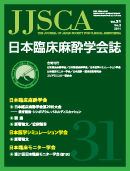Volume 31, Issue 2
Displaying 1-27 of 27 articles from this issue
- |<
- <
- 1
- >
- >|
Journal Symposium (1)
-
2011Volume 31Issue 2 Pages 193-201
Published: 2011
Released on J-STAGE: May 02, 2011
Download PDF (1240K) -
2011Volume 31Issue 2 Pages 202-208
Published: 2011
Released on J-STAGE: May 02, 2011
Download PDF (1778K)
Journal Symposium (2)
-
2011Volume 31Issue 2 Pages 209
Published: 2011
Released on J-STAGE: May 02, 2011
Download PDF (121K) -
2011Volume 31Issue 2 Pages 210-220
Published: 2011
Released on J-STAGE: May 02, 2011
Download PDF (1963K) -
2011Volume 31Issue 2 Pages 221-225
Published: 2011
Released on J-STAGE: May 02, 2011
Download PDF (959K) -
2011Volume 31Issue 2 Pages 226-234
Published: 2011
Released on J-STAGE: May 02, 2011
Download PDF (1741K) -
2011Volume 31Issue 2 Pages 235-241
Published: 2011
Released on J-STAGE: May 02, 2011
Download PDF (1232K)
Journal Symposium (3)
-
2011Volume 31Issue 2 Pages 242
Published: 2011
Released on J-STAGE: May 02, 2011
Download PDF (117K) -
2011Volume 31Issue 2 Pages 243-249
Published: 2011
Released on J-STAGE: May 02, 2011
Download PDF (966K) -
2011Volume 31Issue 2 Pages 250-257
Published: 2011
Released on J-STAGE: May 02, 2011
Download PDF (977K)
Journal Symposium (4)
-
2011Volume 31Issue 2 Pages 258
Published: 2011
Released on J-STAGE: May 02, 2011
Download PDF (128K) -
2011Volume 31Issue 2 Pages 259-267
Published: 2011
Released on J-STAGE: May 02, 2011
Download PDF (672K) -
2011Volume 31Issue 2 Pages 268-274
Published: 2011
Released on J-STAGE: May 02, 2011
Download PDF (838K)
Educational Articles
-
2011Volume 31Issue 2 Pages 275-281
Published: 2011
Released on J-STAGE: May 02, 2011
Download PDF (775K) -
2011Volume 31Issue 2 Pages 282-291
Published: 2011
Released on J-STAGE: May 02, 2011
Download PDF (1278K)
Original Articles
-
2011Volume 31Issue 2 Pages 292-297
Published: 2011
Released on J-STAGE: May 02, 2011
Download PDF (346K) -
2011Volume 31Issue 2 Pages 298-304
Published: 2011
Released on J-STAGE: May 02, 2011
Download PDF (377K)
Case Reports
-
2011Volume 31Issue 2 Pages 305-308
Published: 2011
Released on J-STAGE: May 02, 2011
Download PDF (363K) -
2011Volume 31Issue 2 Pages 309-313
Published: 2011
Released on J-STAGE: May 02, 2011
Download PDF (630K) -
2011Volume 31Issue 2 Pages 314-317
Published: 2011
Released on J-STAGE: May 02, 2011
Download PDF (770K)
[JAMS] Original Articles
-
2011Volume 31Issue 2 Pages 320-326
Published: 2011
Released on J-STAGE: May 02, 2011
Download PDF (613K)
[JACM] Journal Symposium
-
2011Volume 31Issue 2 Pages 328-333
Published: 2011
Released on J-STAGE: May 02, 2011
Download PDF (893K) -
2011Volume 31Issue 2 Pages 334-340
Published: 2011
Released on J-STAGE: May 02, 2011
Download PDF (373K) -
2011Volume 31Issue 2 Pages 341-346
Published: 2011
Released on J-STAGE: May 02, 2011
Download PDF (479K) -
2011Volume 31Issue 2 Pages 347-352
Published: 2011
Released on J-STAGE: May 02, 2011
Download PDF (909K) -
2011Volume 31Issue 2 Pages 353-358
Published: 2011
Released on J-STAGE: May 02, 2011
Download PDF (581K) -
2011Volume 31Issue 2 Pages 359-363
Published: 2011
Released on J-STAGE: May 02, 2011
Download PDF (1072K)
- |<
- <
- 1
- >
- >|
